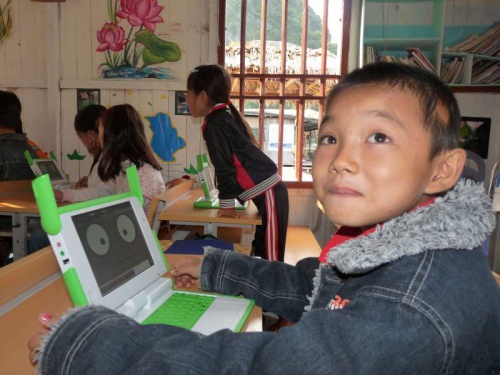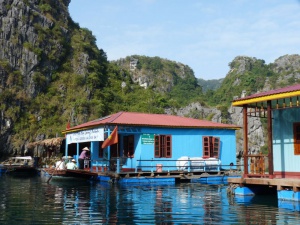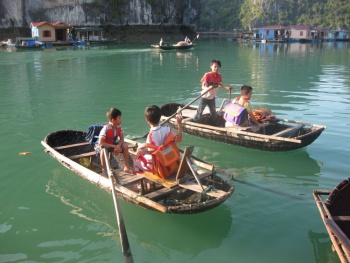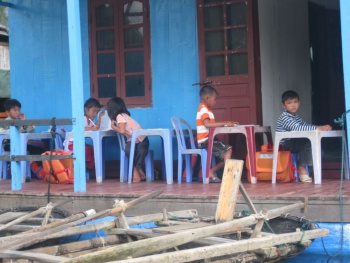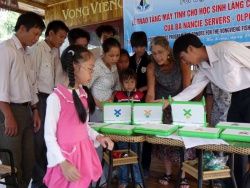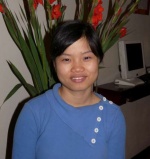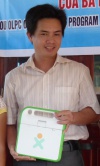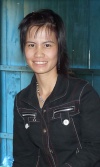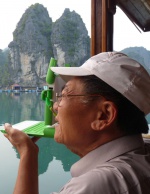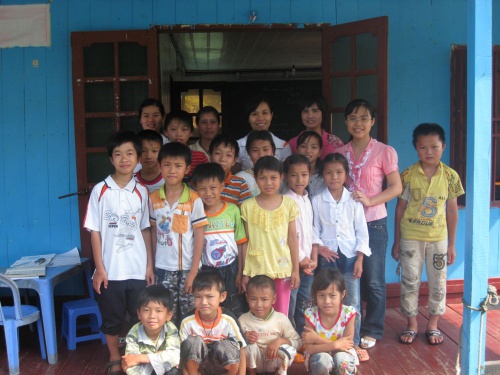Projects/Vung Vieng Fishing Vietnam
Sean Laurence: "I recently attended a presentation given by Nancie Severs, one of our dedicated volunteers. She has just returned from Vietnam where she donated her time to a school in a small floating fishing village. She published a partial account of her experiences organizing a small team to bring One Laptop per Child to the Vung Vieng Village. Read how she overcame environmental, cultural and energy challenges to pilot the first deployment ever to this area of the world."
"One Laptop per Child in Vietnam" video
The Vung Vieng Fishing Village Laptop Project
Location
The Vung Vieng Fishing Village is located in Bai Tu Long Bay, Ha Long Bay, Vietnam. The Village is located about 40 kilometers from Ha Long City, Vietnam. Ha Long Bay and Bai Tu Long Bay are located in Northeast Vietnam approximately 165 kilometers from Hanoi.
Ha Long Bay has been designated as a UNESCO World Heritage Site. Ha Long Bay is truly one of the world's most beautiful spots and natural wonders. It is located in the Gulf of Tonkin, of the Eastern Sea which is labeled the South China Sea on international maps. The salt water bay is approximately 1500 square kilometers and has about 2000 limestone islands or monoliths, some densely forested, arising from the ocean.
Bai Tu Long and the Vung Vieng Fishing Village is off the beaten tourist track as it is not so near to the popular Cat Ba Island which has lodging, beaches and nearby caves where most of the large tour companies and boats operate.
The Vung Vieng Fishing Village has been "adopted" by Indochina Junk, JSC, an eco-tourism company operating in Ha Long Bay, Vietnam. The Indochina Junk Company is interested in supporting this project.
Village and School Description
The Vung Vieng Fishing Village is one of several old fishing villages in Ha Long Bay. There are about 50 families; the population is between 200 and 300 residents. This includes nearly 100 children.
These families have lived in this village for generations. The language is Vietnamese. The village is a "floating village." There are no structures built on land. The village is very poor. Traditionally income for food and potable water (imported from the mainland) came solely from fishing. Now, there is some supplemental income from tourism also.
Vung Vieng Village School
About 7 years ago, in 2002, the local government supported the development of a small school in the village. The village children are served by this school (also a floating structure.) The school consists of 3 rooms. In addition to the main classroom, there are two smaller rooms used for instruction, and for the teachers to sleep/live.
Teachers reside on site during the week and return to the mainland on the weekends. The school is a primary school only.
Approximately 24 children currently attend regularly.
Their ages range from 7 to 13 years old.
There are 4 teachers and the children are divided by age into Forms 1 - 5. There are a number of village children ages 10 to 15 that do not attend school. It is rare for children to continue their education beyond primary school. I know of only one village young adult who graduated from high school on the mainland.
The children who attend school are very motivated. They work really hard under difficult learning conditions. Books, paper, school supplies and teaching aids are minimal. The classroom is often very sunny. It can become very hot, or cold, and the students often spill over to small porch outside, and to small boats tied up to the building. Many of the children have never been on the mainland. They have no firsthand familiarity with vehicles other than boats, with farm or wild animals, retail establishments, or even the geography of the outside world.
Ha Long City, Vietnam the nearest small city is 40 km away by boat. The Vung Vieng Fishing Village receives necessities from Ha Long City. Supplies, Internet cafes and one computer repair shop can be found there.
Project Size
- 35 Laptops
- 1 School Server with one access point/antenna.
- 1 more information at www.charmingindochina.com
Project Members
- Project Leader
OLPC Volunteer
Mr. Tuyen Luong, Indochina Junk Company, Ha Long City, Vietnam
- Vung Vieng Village Liaison, Transportation, and Translator - Vietnam Project Co-Director,
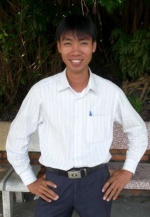 The idea for the Vung Vieng Fishing Village Laptop Project began when Tuyen saw me using my XO on the Indochina Junk's "Red Dragon" in February, 2009. Tuyen and I began building our Team in November and December, 2009.
The idea for the Vung Vieng Fishing Village Laptop Project began when Tuyen saw me using my XO on the Indochina Junk's "Red Dragon" in February, 2009. Tuyen and I began building our Team in November and December, 2009.
Kimberley Quirk, The Energy Emporium, Enfield, NH, www.energyemp.com, kim@energyemp.com and Dr. Thanad Katpradit, Managing Director of Engineo Energy Shop, Chiang Mai, Thailand, www.engineo.co.th
- Power Consultants
Ms. Nguyet, Hanoi, Vietnam
- IT and Graphic Arts Team Member
Ms. Hong, Vung Vieng Fishing Village, Vietnam
- On Site Coordinator and Instructor
- VVV School Teachers
Mr. Ninh
- On Site English and XO Skills Support
We hope to add:
- One person from a Computer Repair Shop in Ha Long City
- One person from the college where the teachers receive training;
- Any interested OLPC people working on Vietnam.
Objectives To Benefit OLPC/Sugar
1.To Generate Interest and Excitement for Small Deployments of XOs. A successful deployment in this very unique site will be visible to visitors from many nations, generating interest and excitement for OLPC. Small deployments around the world are a good business model to keep the OLPC Laptop Project excitement alive, and to effect change, one child, one school, and one community at a time.
2.To Provide a Deployment Model and Activity Model. This project will be a good deployment and activity model for the OLPC Community. I will publish the "how tos" of the Vung Vieng Fishing Village Laptop Project with the OLPC/Sugar Community, from the very idea and preparation, to site visit details for fact-finding, team building, XO demonstration, community building and initial teacher training; how to solve technical and power issues, and later, the XO Activities. See ClassAct Entry here.
3.To Provide Follow-Up And Assessment. It has been difficult for OLPC to obtain follow-up and assessment information on deployments where the XOs have been purchased outright, especially on large government deployments. Hopefully,the initial XOs for the first stage of the deployment will come from the OLPC Contributors Program.
A condition of receiving/using these XOS will be willingness to participate in follow-up by the VVV Laptop Project Team in Vietnam. The VVV is isolated, but it is visited regularly by a group of tour boats. This site is unusual in that team members from outside of the village can visit regularly. They have English skills, internet connectivity and email for help and support, and for sharing follow-up information.
Additionally, the remote location is accessible to other interested members of the OLPC/Sugar Community for site visits. The school is accustomed to scheduled visitors and visits will not disrupt the children's school day.
Vung Vieng Fishing Village Project Objectives
This village is very poor. During certain times of the year, it is not unusual for families have only two meals a day. Only 25% of the young adults and adults in the village can read.
The Vung Vieng Village School has very few school supplies. Responsibility for family is a very high priority. Young adult and adult children support take care of their parents and grandparents. Long term measurable objectives of the Vung Vieng Fishing Village Laptop Project are:
1. To increase literacy and computer literacy among children and adults in the community;
2. To prepare a higher percentage of village children for secondary school and work opportunities in and outside of the village;
3. To achieve an increase in subsistence income for the families, and improved child nutrition and health through the visibility and partners of the Vung Vieng Fishing Village Laptop Project and by education gains.
4. To create a pool of home grown "young adults" and "adults" who can contribute to the future financial support, education, governance, and community life of the Vung Vieng Fishing Village.
Shorter term measurable goals for the XOs in the VVV school include:
1. To increase the availability of teaching resources in a location that has very few teaching materials. The pre-loaded Activities on the XO that do not require knowledge of English alone, will have a major impact. For example, the XOs will provide teachers and children with new pre-loaded learning tools for math; e.g., Calculator, Memory Game for fact drilling, and Ruler, science; e.g., Measure and Moon, art; e.g., Paint and once more advanced, EToys, Scratch, and Turtle Art, music; e.g., the 4 Tam Tam activities, and photography; e.g., Record. The solar power for this project will provide a hands on science curriculum that can potentially benefit the community.
2. To introduce the village children to basic computer skills and to provide a tool for creative, hands-on collaborative learning; to make school more fun, encouraging learning and resulting in increased literacy.
3. To retain children as students beyond the 3rd Form. To increase school attendance among children ages 10-13, the age where many drop out.
4. To engage the family and community in encouraging the children to go to school.
Initial Request from the Contributors Program
- 10 New Laptops with Power Cords;
- 2 Salvaged/Damaged Laptops for Parts and Learning to Repair; and
- 10 or more Charger Cables with tips to fit the XO for a "charging station." Other "portable" hardware that may be available that may help us address power issues.
- Loan Length—How Many Months: Undetermined
Plan of Action
- The immediate plan is to hand carry the requested laptops into Vietnam (via Thailand) early November, 2009.
We will use them as follows:
- Four XOs are for the 4 village teachers (they rotate and each require their own for learning and curriculum development.)
- Four XOs are for a student "pilot" for teacher training and experimentation. One working laptop is needed off site for repair training along with the 2 salvaged/damaged XOs.
- One XO is for the college where the teachers are trained, or for another new team member.
In early November, 2009 we will introduce the XOs and the OLPC Project to VVV community, potential corporate partners, teachers, and a government liaison. Team building, XO training and instruction for OLPC chat for help support and follow up will be introduced. The Contributors Laptops will remain in Vietnam. We will be addressing such issues as power - solar/generator combination, developing a budget for the project, fundraising, shipping, etc. on this trip.
- After 5 or 6 weeks, in December, 2009 I will personally return to the Vung Vieng Village, for follow up and to determine whether this project can be sustainable. If so, fund-raising goals and activities will be established. A timeline will be set for attaining reliable power and for when laptops can be distributed to all of the Vung Vieng Fishing Village schoolchildren.
Needs
Donations: This project is the vision of two individual volunteers, Nancie Severs, NH, USA and Tuyen Luong, Vietnam. We greatly appreciate your consideration of our mission.
We are in need of funds for laptops, one for every child in the Vung Vieng Village School, and for expenses relating to power and project infrastructure.
If you are interested in making a donation, please contact nanciesevers@gmail.com and include OLPC in the subject line. We gladly accept previously used XO laptops.
Thank you for your generosity!
Power
The Vung Vieng Fishing Village is off the power grid. Most homes have a generator that provide power for 3 to 4 hours a day, plus or minus. Satellite signals are available for eventual internet connectivity.
- The school is a full sun site with strong and predictable seasonal solar capacity. Obtaining a generator for the school to charge the Contributors Program Laptops is the first priority for this deployment.
- Environmentally clean power is the project goal.
- The goal is to have a charging station in the school similar to the Nepal cabinet, that can charge 1/3 to 1/2 the XOs at a time. The plan is to have solar panels and a back up generator connected through a charger controller to a battery bank.
Following are links for two simple power diagrams that can be printed.
Simple Solar powered XO diagram Generator plus Solar powered XOs diagram
- I will bring up the idea of wind power also. But because the village is located in the midst of a UNESCO World Heritage site, I suspect that windmills will not be a viable option.
An Introduction To Off-Grid Solar Power
What is an off-grid power location? Off-Grid locations are locations that do not have connection to conventional power from a utility or government power company.
How much electricity can an off grid solar electric system provide? An off -grid Solar electric system can provide anywhere from 25% to 95% of your annual power needs depending on site conditions, energy use, and the system size.
How Long Do Solar Panels Last? Solar photovoltaic (PV) Panels typically have a manufacturer's warranty that guarantees power production for 25 years. Many experts predict that PV panels will continue to work well formore than 40 years. Solar panels have no moving parts to break,and they have a long life with very low maintenance. Today, more than 90% of PV panels in use since the 1960's and 1970's still produce power!
How Do The Solar Panels Work? The solar panels collect energy from the sun and convert it into "direct current" (DC) electricity. The photovoltaic (PV) array captures photons fromthe sun and converts them into DC power.
What Would a System To Charge XOs Look Like? See Diagram Links above.
- Small electronics like the XO can be wired directly to a solar panel and charged. But there is no way to control the amount of energy coming in and depending on what you are charging, it could receive too much energy and burn out. XOs have a built in controller to protect them from overcharging. They whistle and sing if they receive more power than needed.
If you use 12 volt to 18 volt solar panels, you might not need a "charge controller." If the PV panels are 24 volts, you will need a charge contoller. The time to charge an individual XO will depend on the size of the panel used, and the sun conditions.
- To charge multiple XOs, the PV panels are connected to a charge controller and the charge controller is connected to a 12 volt battery or to several 12 volt batteries (a battery bank). The charge controller monitors the amount of energy coming from the PV panels. It works like a surge protector to keep the batteries from receiving more energy than they an handle, on a very sunny day. It ensures that the battery or battery bank charge level needed to produce the electricity you want to use is maintained.
- An XO can be connected to the battery to be charged, or several XOs can be connected to the battery or battery bank through a terminal block.
- A generator can be added with its own charge controller, to provide back up power to the battery bank for times when sun conditions are not ideal.
- Charge controllers are unique to the energy source. Generator power and solar power each require their own specific type of charge controller.
- To convert the DC power from the solar panels into "alternating current" (AC), the type of power to plug the standard XO adapters into, and to run appliances, lighting and electronics, a DC to AC inverter can be added. The inverter changes the DC electricity from the panels into AC 'alternating current" (AC) power.
What materials are required for an Off Grid Solar Only Power System? PV array panels and battery bank Design sized to meet the anticipated electricity needs. PV Solar panel/s and mounting rack if needed. Efficient deep cycle storage batteries and a safe battery box. A PV charge controller with MPPT (maximum power point tracking which makes sure the battery charge level is maintained. A DC to AC inverter at the correct current for the plugs used. Properly sized conduit, wiring, disconnects, and fuses.
Add a Generator and Generator Charge Controller for generator back up power to the battery bank.
Be sure to properly and safely install and maintain the equipment!
Sharing Deliverable/s
- See Objectives to Benefit OLPC/Sugar, above. To accomplish these, I have a travel blog at:
http://www.travelpod.com/travel-blog/nsevers/4/tpod.html for regular updates while in Southeast Asia. In the future, the travelpod website may have a fund-raising piece built into it. I will be in Frequent Contact with the Support Gang for problem-solving and brainstorming during while traveling.
- Bi-monthly Reports. A bi-monthly report form will be used for follow-up reports from the project site. It will include how the X0s are being used, what hardware, power and software problems are being encountered, and what curriculum and learning strategies are working well. I will post monthly to the travel blog site and post summaries directly to the VVV OLPC Project Site.
- Visibility for the OLPC XO Laptop Project. If the deployment is successful, I envision promotion to increase tourism on Indochina Junk, JSC, the eco-tourism partner that will hopefully be teaming to support this project. Indochina Junk as a company is very sensitive to the cultural and environmental preservation of the Vung Vieng Fishing Village. They limit visitors to very small groups at a time but the visits are consistent and bring many people from all over the world during the year. Many tourists interested in humanitarian projects will be introduced to the OLPC XO Laptop Project through this deployment. This project site will be available to individuals or groups who wish to visit an OLPC project.
- Assessment methods to measure the goal attainment will also be developed.
- I will continue to volunteer with the Support Gang to mentor new small deployments and share my experiences.
Timeline
- Milestone 1: November - December, 2009
Successfully Deliver Contributors Program Laptops To the VVV, and accomplish Plan of Action as outlined in 1 and 2 above.
- Milestone 2: January - June, 2010
Achieve Design for a Classroom Server with one access point. Achieve Design for a Charging Station capable of charging 1/3 or 1/2 of the number of laptops to be deployed, simultaneously. Begin the fund-raising initiative and raise the funds necessary to implement the full deployment.
- Milestone 3: November - December, 2010
Delivery of 25 XOs to Ha Long City, Vietnam. Stress test XO's, school server, active antenna, and mesh networks prior to handout. A Handout Ceremony will be preceded by a mandatory class on the Proper Use and Care of the XOs, for which Certificates will be given.
- Milestone 4: To have funds available to sustain on-going project costs, from corporate sponsors and other fund-raising initiatives to take place in Vietnam.
Equipment Inventory
I hope that sharing this will help mentor other small deployments. I will add useful items to this list as we acquire them. Some of the items are perhaps unnecessary but fun or helpful. As an OLPC volunteer, I am paying my own expenses of travel and lodging. I am of course bringing additional gifts with me also. Please contact me if you have questions re: expenses/costs.
11 Contributors Program XOs Laptops and plug adapters 1 XO from DC with adapter from ilovemyxo.com 1 XO G1G1 Donation from Michelle and Koen Cooper in Canada 1 new battery (in case of a bad one) from ilovemyxo.com 15 tip cords without plugs (for addressing power issues) 2 "IGO" 12 Volt cigarette lighter portable chargers(iGo auto/air power 40 Model #6630015-04-00. The 00 tip fits the XO) 12 green and white earbuds 5 Flash storage USB sticks (2G and 4 GB) 2 USB to Lan adapters Various cables I predict will be useful 1 Printed OLPC Laptop Manual 1 Printed Sugar Manual (from Lulu) 5 Green and White Mouses 6 Microphones 6 Powerstrips (for charging)(2 locations) 1 Solar Power Charge Controller 13 Solar Panels 2 200Ah, 12 volt batteries 1 Inverter DC to AC
Donors
The Vung Vieng Village residents, children and teachers gratefully appreciate everyone who has contributed to their OLPC XO Laptop Project.
Thank you
Mr. Dung, Director, Indochina Junk, JSC for your Corporate Sponsorship and Donations of Time, Employees, Office Space,Transportation, Equipment, Food, and more. Mr. Dung works tirelessly to improve the lives of the VVV residents! Mr. Tuyen Luong, Tour Guide Manager at Indochina Junk, JSC for your personal contribution of time and money, your patience, persistence and humour! Mr. Mark B. Severs, for financial support and continued encouragement. Mark financed Nancie's travel expenses, and the purchase of most of the equipment listed in the Inventory. OLPC Contributors Program for the first XO Laptops.
The following donors have generously re-donated their G1G1 XOs to this project: Michelle and Koen Cooper, British Columbia, CA Karl Wiedergott, California Ethan Meyer, California Anonymous, Pennsylvania Kathleen Archer, Connecticut Vivia Tatum, North Carolina Anita Simons, California Neil Card, Ontario, CA Mike Chin, Vancouver, CA Denny Dobbin, North Carolina
Please contact nanciesevers@gmail.com to make a donation and add your name to this list!
Project Updates
August, 2011
Serge Stinckwich reports from Vietnam:
"I made a short visit in the Vung Vieng village in August. The computers are still in good conditions and used by the children. When I made a visit this was holidays and the children were not here, but
I talked with a guy who is responsible for the fishermen in the village if I understand correctly. He is really interested to have some help from us. What is lacking apparently is some training for the local
teachers (they only stay one year in the village).
I think we need to setup a task force to help the Vung Vieng Fishing Village deployment. If there is enough people interested, we could try to prepare a more update version of the sugar image to deploy on current laptops and prepare some training materials for the teachers. I think this is quite important to explain them the philosophy behind OLPC (this ispart of a broader movement) and how they can use the laptops. Maybe they have some specific needs that we don't know."
This is really good news that all of the equipment, the XOs and presumably the solar power to charge them with still works! This reflects that the people in the village have taken really good care of the XOs and shows that the XOs can work in a very rugged and damp environment.
Communication continues to present challenges both vis a vis the language barrier and the remote location of the VVV. Internet in the VVV could link the members of OLPC Vietnam that can provide IT support with XO users in the village. The OLPC Vietnam Google Group discussions can be found here: [1]
March 15, 2011
I am happy to report that the XO Manual is now available in Vietnamese. Dedicated volunteers in Hanoi have just about completed the translation so that XO/Sugar users and potential users can read the manual in Vietnamese. This will be very useful. Thanks to Vu Do Quynh for organizing the session and providing snacks, and to everyone who has helped with this important project!
The Vietnamese chapters can be found here!
[2]
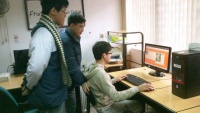 OLPC Vietnam Volunteers Translating the XO Manual
OLPC Vietnam Volunteers Translating the XO Manual
October 20, 2010
Check out the new OLPC Vietnam web page at:
[3]
Here you can join our Google Group of OLPC Vietnam Volunteers, learn about our activities and participate in discussions. As of today, we have 47 members of our group!
Volunteers Lilly, Nguyet, Yang and others put together a terrific presentation which was very well received at the Vietnam Software Freedom Day last month. A summary and links to the presentation and photos can be found here: [4]
This week, I received 3 gently used XOs generously donated by Mike Chin and sent to me from Vancouver, Canada. Thank you Mike! I will check them out and perform any necessary repairs, replace the batteries, and get them ready for use by Vietnamese children!
Please pass the word around. OLPC Vietnam still needs XOs! Thanks to everyone who has donated!
September 10, 2010
Watch for updates soon. September 18 is Vietnam's Software Freedom Day. There will be events in Hanoi. Our new group of OLPC Vietnam Volunteers in Hanoi will have a presentation and 2 or 3 demo XO-1's from the VVV inventory to share.
June 5, 2010:
The seeds Marina and I planted in Vietnam are sprouting...:)
Serge Stinckwich works with the Open Learning Community (OLE) in Hanoi. He is an expert at Squeak-Etoys.This Activity uses Etoys to program robots. Serge recently organized the first meeting of interested OLPC volunteers in Hanoi to recruit developers and IT support for the micro-projects in Vietnam. The meeting was held on Saturday, June 5, 2010. Serge's terrific photos are at: http://www.facebook.com/?ref=home#!/album.php?aid=221797&id=538054947&ref=pb
WOW! I counted at least 15 people. Ms. Nguyet brought the two Donate Your Get One XOs that Dr. Sam Venus recently delivered to Hanoi to the meeting for live demos. Mr. Vu Do Quynh did some teaching and obviously had Sugar on a Stick working. I am so excited and pleased to see the OLPC Vietnam community taking root.
Details: Serge gave a short presentation of the OLPC project and a report of his recent visit to the Vung Vieng village. The slides (report of the VV village visit) are available here: http://www.slideshare.net/SergeStinckwich/visit-to-vung-vieng-village-olpc-vietnam
Mr. Quynh tested Sugar on a Stick (SoaS, Fedora 13) and Trisquel-TOAST 3.0 before the meeting. His preference went to Trisquel TOAST http://wiki.sugarlabs.org/go/Trisquel_On_A_Sugar_Toast and also Trisquel 3.5 Arwen (based on Ubuntu 9.10): http://trisquel.info/ He said, "it was very easy to install the Sugar environment so that either development could be done (new activities) and use of Sugar sessions being done. What was displayed on the video-projector as shown by Serge's photos was actually a Sugar session with Trisquel 3.5 Arwen."
May 30, 2010:
OLPC Vietnam in US Volunteers Meet OLE Nepal in Boston! Marina and Nancie met Rabi, the Executive Director of OLENepal in Boston. http://www.travelpod.com/travel-blog-entries/nsevers/4/1275263833/tpod.html
OLE Nepal's website has a wealth of resources for the OLPC community to share. See www.olenepal.org I am so excited to learn about the curriculum and library that OLE Nepal has developed for the 2000 XOs already deployed there. These include interactive digital learning materials that conform to Nepal’s national curriculum: http://www.olenepal.org/e_paath.html and a web-based library of open, free, and high quality educational resources for teachers and students: http://www.olenepal.org/e_pustakalaya.html If the OLPC/Sugar community can help OLE Nepal translate the necessary portions of this into English, then this open course-ware can be used in Englsih classroom settings, and the code can be adapted/translated into Vietnamese for use in Vietnam! And Thai, Spanish, Hindi, and, and, and....
April 10, 2010:
VVV Video hits YouTube! http://www.youtube.com/watch?v=-Q8K_FpDnaI This video will make you feel like you are on the rowboat in Ha Long Bay, Vietnam. Once there, you can see the school childrens' first lesson on their new XO Laptops from One Laptop Per Child! Thanks go to Sean Laurence for his excellent editing skills and music. Please help us to get many viewers! You won't want to miss this film!
April 8, 2010:
Dr. Sam Venus, Mayo Clinic, Minnesota, brings 2 re-donated G1G1 XOs to Hanoi! Ms. Nguyet met Dr. Venus and received the XOs. Thank you Dr. Venus! Nguyet has met Marina also and has learned many new things on the XOs. Thank you Marina!
April 1, 2010:
OLPC Volunteer, Marina Verhovzeva visits the Vung Vieng Village! Marina has been teaching girls in a shelter in Ho Chi Minh City to use the XO. She brought 5 XOs with her and has done great things there. This week, Marina traveled via Hanoi to the Vung Vieng Village. She updated the software on the VVV X0s and changed the language to Vietnamese. She taught one class and we all wish she could have stayed longer.
Read about Marina's work on her blog at:
http://sn126w.snt126.mail.live.com/default.aspx?wa=wsignin1.0
Be sure to scroll back to her entries teaching the girls in HCMC too.
March 12, 2010:
Ian Daniher teaches Nancie how to disassemble and repair XOs! The VVV Project has received several re-donated G1G1 XOs in need of repair. The most common problem is the "failure to boot." When powered up, the screen remains black but the battery and power LED's still light up. To repair this problem, the clock must be reset by attaching a serial adapter between the damaged XO and another computer, either an XO or a conventional desktop or laptop and running a set of commands. The repair requires a special serial adapter. I have one now, thanks to the Contributors Program. If you have an XO that you thought was broken, we welcome your donation. We can repair your XO and send it to a child in Vietnam!
You can read more details at: http://www.travelpod.com/travel-blog-entries/nsevers/4/1268682776/tpod.html The repair instructions for this problem are on the OLPC Wiki at: http://wiki.laptop.org/go/Fix_Clock
February 11, 2010:
Blog by Sean Laurence: I recently attended a presentation given by a dedicated volunteer. She just returned from Vietnam where she donated her time to a school in small floating fishing village. Here is a partial account of the experiences of Nancie Severs and her small team. Her plan brought the One Laptop per Child mission to the Vung Vieng village. Read how she overcame environmental, cultural and energy challenges to pilot the first deployment ever to this area of the world.
"The XO Travels to the Vung Vieng Village Floating School in Vietnam"
"The XO Travels to the Vung Vieng Village Floating School in Vietnam" (PDF 6 pages)
February 7, 2010:
Nancie's Project Summary Slide Show to OLPC volunteers in Cambridge, Massachusetts: File:VVV Power Point Presentation PDF.pdf (21 pages)
January 1, 2010:
Delivering Solar Power to the Vung Vieng Village - See Travelpod blog entry at:
http://www.travelpod.com/travel-blog-entries/nsevers/4/1262272595/tpod.html
December 14, 2009:
Meeting and Summary OLPC Thailand - See Travelpod blog entry at:
http://www.travelpod.com/travel-blog-entries/nsevers/4/1261874432/tpod.html
November 2, 2009:
Teaching the XO to the VVV Schoolchildren - See Travelpod blog entry at:
http://www.travelpod.com/travel-blog-entries/nsevers/4/1257600492/tpod.html
October 29, 2009:
Ceremony To Receive XO Laptops
Le Trao May Tinh Xach Tay XO
Vung Vieng Village School
Truong Hoc Lang Chai Vung Vieng
Bai Tu Long Bay, Halong Bay Vietnam
Bai Tu Long, Vinh Ha Long, Viet Nam
The Vung Vieng Village Teachers and Children Have 12 XO Laptops!
October 14, 2009:
The Vung Vieng Fishing Village Laptop Project Journal is all set. I will post project travel entries and photos at:
http://www.travelpod.com/travel-blog/nsevers/4/tpod.html
September 25, 2009:
The OLPC Contributors Program has approved this Project!
The Vung Vieng Fishing Village Residents And Schoolchildren Say Thank You To OLPC!
